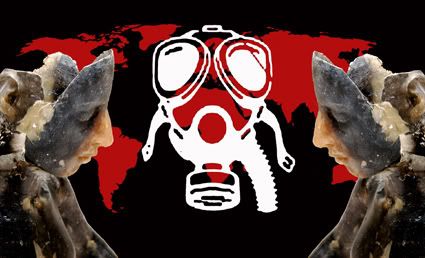




Excerpt of the catalogue presentation of NOW written by Gloria Vallese, historian of art and curator of CREAM ON MADNESS.
Eleven human figures are gathered in a group. Two of them hold a sheet, looking at something inside it. They are children: slender-bodied, with innocent, curious expressions. But they are also black, horribly burn; they are walking corpses, although they do not seem aware of it. What we see within the sheet, is the spectral face of a gas mask. It it a toy? They do not seem to know. Seen closely, these tragic figures are also exquisite pieces of sculpture: the sweetness of the strange, half-burned faces is something that stays in the memory of the observer. Among the works devised by CREAM for Open 11, this by Giacomo Roccon is the most classically sculptural, based as it is on the physical impact of the three-dimensional figures, and on skilful moulding.
The work alludes to the scandal of child soldiers, an horror of our time; but also to the disturbing and eternal mystery of children who dream the war make it a play, and, unaware of pain and death in real life. But the layers of meaning do not detract from the formal beauty of this strong group of sculptures. Conceived in ideal relationship with the terracotta Chinese army of Ch'in Shih Huang Ti, the small platoon of children soldiers interacts with the idyllic peace and the silence of the garden of San Servolo, which forms a deep contrast with the disturbing message from the author.
Who, in this case, focuses on notes for him unusually delicate, being in other occasions a rather robust hyper-realistic sculptor. As in Game Over, lifesize figure of a young pregnant woman sitting on the ground, numb and dishevelled, surrounded by cases of cigarettes and pills (Prize ARTE 2006 for sculpture, in the section Academies of Fine Arts). Or in Fallen Angel, a work created in 2006 for Open 9, life-size human figure bandaged from neck to foot in white gauze that left only the face uncovered, suspended by chains to the metallic beams of the outdoor structure in which it was exhibited (a vague evocation of the medieval habit of exposing high, at the sight of all, the corpses of the executed). Conceived expressly for the metal carpentry designed to host it, it drew clever benefit from the environmental elements, in particular from the sea breeze which slightly and melancholically rocked the inert figure and its long hanging hair.
NOW, 2008, resina poliestere, ferro, stoffa, dimensioni variabili
Eleven human figures are gathered in a group. Two of them hold a sheet, looking at something inside it. They are children: slender-bodied, with innocent, curious expressions. But they are also black, horribly burn; they are walking corpses, although they do not seem aware of it. What we see within the sheet, is the spectral face of a gas mask. It it a toy? They do not seem to know. Seen closely, these tragic figures are also exquisite pieces of sculpture: the sweetness of the strange, half-burned faces is something that stays in the memory of the observer. Among the works devised by CREAM for Open 11, this by Giacomo Roccon is the most classically sculptural, based as it is on the physical impact of the three-dimensional figures, and on skilful moulding.
The work alludes to the scandal of child soldiers, an horror of our time; but also to the disturbing and eternal mystery of children who dream the war make it a play, and, unaware of pain and death in real life. But the layers of meaning do not detract from the formal beauty of this strong group of sculptures. Conceived in ideal relationship with the terracotta Chinese army of Ch'in Shih Huang Ti, the small platoon of children soldiers interacts with the idyllic peace and the silence of the garden of San Servolo, which forms a deep contrast with the disturbing message from the author.
Who, in this case, focuses on notes for him unusually delicate, being in other occasions a rather robust hyper-realistic sculptor. As in Game Over, lifesize figure of a young pregnant woman sitting on the ground, numb and dishevelled, surrounded by cases of cigarettes and pills (Prize ARTE 2006 for sculpture, in the section Academies of Fine Arts). Or in Fallen Angel, a work created in 2006 for Open 9, life-size human figure bandaged from neck to foot in white gauze that left only the face uncovered, suspended by chains to the metallic beams of the outdoor structure in which it was exhibited (a vague evocation of the medieval habit of exposing high, at the sight of all, the corpses of the executed). Conceived expressly for the metal carpentry designed to host it, it drew clever benefit from the environmental elements, in particular from the sea breeze which slightly and melancholically rocked the inert figure and its long hanging hair.
NOW, 2008, resina poliestere, ferro, stoffa, dimensioni variabili




Nessun commento:
Posta un commento